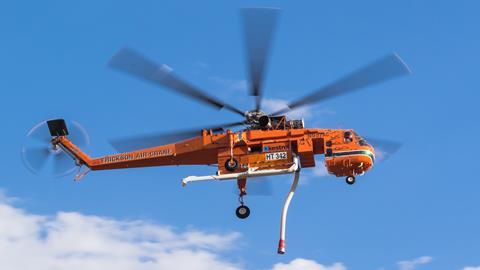Erickson is pitching the US Army on an autonomous variant of its heavy lift Air Crane helicopter, the S-64F+.
The company believes the S-64F+ could compliment the service’s fleet of Boeing CH-47 Chinooks, and also Sikorsky CH-53 heavy lift helicopters, which are operated by the US Marine Corps, by supporting training and logistics operations, it said on 23 February.

The S-64 is a commercial variant of the 1960s-era Sikorsky CH-54 Tarhe, a twin-engined heavy lift helicopter built for the US Army. The rotorcraft has an empty space where a passenger cabin is typically placed and that allows for carrying special loads, including a shipping container, a water tank or a large sling load.
Erickson purchased the intellectual property of the S-64 from Sikorsky in 1992. The company produces a few of the helicopters each year as new-builds or via remanufacturing legacy CH-54 airframes at its facilities in Medford, Oregon.
The firefighting version of the S-64 can carry a 10,000 litre (2,650gal) water tank in its belly. The airlifter configuration of the helicopter is sometimes used for timber harvesting, powerline tower construction and HVAC system placement on tall buildings.
Erickson announced in 2020 that it had partnered with Sikorsky to give the S-64 autonomous flight abilities. The helicopter’s mechanical flight controls are to be removed and replaced with fly-by-wire controls and Sikorsky’s Matrix autonomous flight control technology. Sikorsky’s Matrix-controlled helicopters, such as a retrofitted UH-60A Black Hawk, have relied on sensors, such as Lidar and cameras, as well as digital terrain obstacle databases, to guide their autonomous flights.
At the time, Erickson said it believed the Matrix system’s sense-and-avoid abilities could allow the S-64 to conduct firefighting water drops during night or in low-visibility situations, such as when a pilot’s sight is clouded by smoke. The company believes its autonomous abilities could be extended to US Army operations. The US Marine Corps used an autonomous variant of the Kaman K-Max in Afghanistan to ferry cargo and is working on developing improvements to the unmanned heavy lift helicopter.
Erickson has yet to demonstrate the S-64F+.
“The first F+ is in the queue for assembly now, so we have not flight tested it yet,” says Jeff Baxter, senior director of research and development at Erickson. “That said, the Sikorsky S-70, and UH-60 test beds that have the exact same [Matrix] kit as is being integrated to our aircraft have accumulated several hundred hours of flight testing.”
Existing Air Crane helicopters can be upgraded to the F+ configuration, but Erickson plans to sell new-build airframes to new customers.
The company thinks there is a business case for purchasing the S-64F+ or offering it as a company-owned, company-operated service. Erickson operates a fleet of S-64s as a commercial service. The firm also sees a market for leasing the aircraft.
“Erickson intends to continue to operate the S-64 Air Crane aircraft in support of our customers, while also serving customers who prefer to purchase the aircraft,” says Baxter. “Being an operator makes us a better OEM and vice versa.”
Article corrected to note that Erickson believes the S-64F+ would complement US military service heavy lift helicopters



























